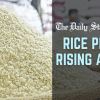How AI can forecast rice market shocks in Bangladesh

Rice accounts for about 60 percent of daily caloric intake in Bangladesh and occupies approximately 76 percent of the total cropped land. Despite consistently producing around 39 million metric tonnes of rice annually, the country's rice markets remain vulnerable to sudden price surges. These disruptions are often driven not by production shortfalls but by supply chain bottlenecks or environmental stresses.
For example, in August 2023, coarse rice prices surged by 13 percent in just one month, even though production remained stable and Aman harvest output surpassed the previous year's by 500,000 tonnes. These shocks disproportionately affect poorer households, where even a Tk 2 per kg rise significantly impacts food budgets.
Artificial Intelligence (AI) offers a powerful tool for anticipating and managing these shocks. Ensemble learning models such as gradient boosting, CatBoost, and XGBoost have demonstrated exceptional performance in forecasting rice yields in Bangladesh, with R-square values nearing 0.99 (the higher the R-square, the better a model fits the data). In contrast, rice price forecasting is more complex. Models like Vector Autoregression (VAR), used in markets such as Malaysia, show R-square values between 0.60 and 0.80, reflecting moderate explanatory power. Time series approaches such as ARIMA, applied to Bangladeshi data, have shown promise in predicting yields but limited applicability to price dynamics.
AI systems that integrate environmental variables—rainfall, temperature, and wind speed—can help forecast potential price disruptions. Satellite-based AI pilots in Southeast Asia have successfully detected crop stress up to two weeks before visible signs appear, allowing for earlier intervention. Similar systems in Bangladesh could prompt timely responses, such as adjusting public procurement or releasing food reserves, before prices escalate uncontrollably. This proactive approach can play a crucial role in stabilising the rice market, particularly during climate- or logistics-related uncertainties.
However, the successful implementation of AI in agriculture faces structural challenges. Wetland areas such as haor and char lack reliable internet connectivity, hindering real-time data collection. According to a report by The Daily Star, only 37.8 percent of rural residents in Bangladesh use internet, compared to 68.4 percent in urban areas. This stark rural-urban digital divide significantly limits AI adoption.
Price data at the district level is often collected manually or inconsistently, which reduces model training accuracy. In Bangladesh, and more broadly across South Asia and Africa, tech-driven agriculture is hindered by limited digital literacy, inadequate technical training, and poor data-quality awareness among farmers and officials. This shortage is recognised as a "key barrier" to the effective use of AI: officials cannot interpret models, lack trust in forecasts, and therefore underutilise them. Addressing these foundational issues is essential for any AI-driven solution to have a real impact.
To move forward, Bangladesh should pilot AI forecasting systems in key rice-surplus districts such as Naogaon, Bogura, and Jessore—regions where rice dominates local GDP. Extension offices could be equipped with tablets and dashboards to access real-time AI alerts. At the national level, a unified digital rice price database with real-time feeds from wholesale markets would vastly enhance model accuracy. Equipping local officials and traders with the knowledge to act on such signals would enable them to incorporate AI insights into market-level decisions.
By combining machine learning with real-time data and institutional readiness, AI can help the country move from reactive crisis management to forward-looking food policy. Rice in every table, every household stands to benefit when markets are predictable, prices are fair, and intelligent systems guide national food security.
Ellin Ahmed is a finance major at the Bachelor of Business Administration (BBA) department of North South University. He can be reached at [email protected].
Views expressed in this article are the author's own.
Follow The Daily Star Opinion on Facebook for the latest opinions, commentaries and analyses by experts and professionals. To contribute your article or letter to The Daily Star Opinion, see our guidelines for submission.

 For all latest news, follow The Daily Star's Google News channel.
For all latest news, follow The Daily Star's Google News channel. 










Comments